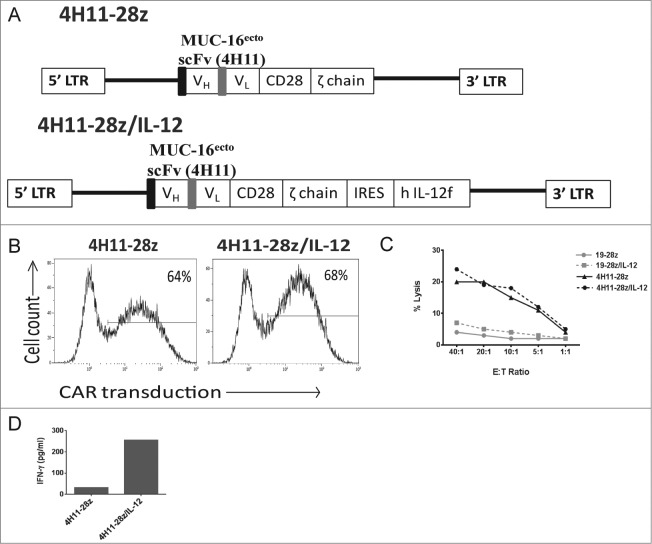Figure 1.
Design and production of IL-12 secreting 4H11-28z T cells and in vitro studies of 4H11-28z/IL-12 T cells compared to second-generation 4H11-28z CAR T cells. (A) Schema of 4H11-28z and 4H11-28z/IL-12 retroviral vectors. 4H11 scFv: MUC16-specific scFv derived from heavy (VH) and light (VL) chain variable regions of the mAb 4H11; CD28: human CD28 transmembrane and cytoplasmic signaling domains; ζ chain: human TCRζ chain cytoplasmic signaling domain; flexi human IL-12 (hIL-12f); LTR: 5′ and 3′ long terminal repeat; black box: CD8 leader sequence; gray box: (Gly4Ser)3 linker. (B) Flow cytometric analysis of transduction efficiency using a 4H11-CAR specific antibody. Transduction efficiencies achieved were routinely >50%. Data shown is representative of >7 independent experiments. (C) The ability of CAR T cells to lyse SKOV3 (MUC-16ecto) ovarian cancer cells was assessed using a 4-h 51Cr release assay. CAR T cells targeting tumor cells demonstrated increased killing by 4H11-specific CARs compared to irrelevant non-specific CAR T cells (1928z and 19-28z/IL-12). Data shown is representative of four independent experiments. (D) Peripheral mononuclear cells (PBMCs) were exposed to conditioned media overnight from viral producers and the amount of IFNγ in each sample was assessed using a luminex assay. Elevations in IFNγ was seen in 4H11-28z/IL-12 compared to 4H11-28z conditioned media. Data shown is representative of two independent experiments.

